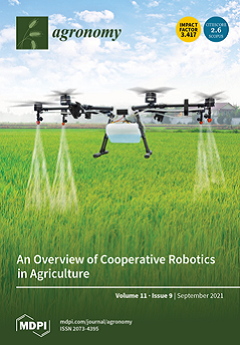This study aims to compare photoacoustic (FTIR–PAS), diffuse reflectance (DRIFT), and attenuated total reflection (ATR) FTIR modalities in the wide wavenumber range from NIR (7500 cm
−1) to FIR (150 cm
−1) for the same silicate soil samples under the same conditions. The possibilities of non-destructive rapid qualitative analysis of soils by these modalities without comprehensive data treatment were compared. The assignment of more than 100 bands for the chernozem and sod-podzolic as common types of silicate types of soil was made. The following groups of bands of organic matter and inorganic matrix were reliably found in spectra of all or at least two modalities: 3690–3680 cm
−1 (hydrogen-bonded SiO–H…H
2O stretch, not ATR), 2930–2910 cm
−1 and 2860–2850 cm
−1 (methylene stretch), 1390–1380 cm
−1, (symmetric stretch carboxylate, DRIFT and FTIR–PAS); 2000–1990 cm
−1, 1885 cm
−1, and 1790–1783 cm
−1 (SiO
2 overtones, DRIFT and FTIR–PAS), 1163–1153 cm
−1, SiO
2 lattice (not FTIR–PAS), 1037 cm
−1 (Si–O or Al–O stretch), 796 cm
−1 (lattice symmetrical Si–O–Si stretch); 697 cm
−1, SiO
2; and 256 cm
−1 (not FTIR–PAS). Amide I, II, and III bands appear in DRIFT and FTIR–PAS spectra while not in ATR. Except for methylene and carboxylate groups, CH vibrations (3100–2900 cm
−1) are not seen in ATR. Bands at 1640–1630 cm
−1, 1620–1610 cm
−1, 1600–1598 cm
−1 (primary water bands and probably carboxylate) appear in the spectra of all three modalities but are unresolved and require data treatment. It is preferable to use all three modalities to characterize both soil organic matter and mineral composition. DRIFT provides the maximum number of bands in all three modalities and should be selected as a primary technique in the NIR and 4000–2000 cm
−1 regions for hydrogen-bonding bands, CH
X groups, and the silicate matrix. ATR–FTIR complements DRIFT and provides a good sensitivity for soil water and the matrix in 2000–400 cm
−1. FTIR–PAS in 4000–1500 cm
−1 reveals more bands than DRIFT and shows the highest sensitivity for absorption bands that do not appear in DRIFT or ATR-IR spectra. Thus, FTIR–PAS is expedient for supporting either DRIFT or ATR–FTIR. This modality comparison can be a basis for methodological support of IR spectroscopy of soils and similar organomineral complexes.
Full article





